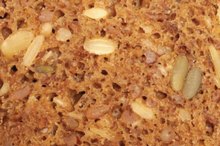Does Whole-Grain Bread Raise Blood Sugar?
Whole-grain bread is made from grain that contains all three of its natural components: the germ, the bran and the endosperm. It differs from bread made with refined grains, which have only the starch-laden endosperm. Whole-grain bread has significant amounts of digestible carbohydrates. Any food that contains digestible carbs will raise your blood sugar, or blood glucose, although some carbs will raise your glucose levels much more than others.
Whole-Grain Basics
Whole grains are classified as complex carbohydrates. This means that they contain starch and fiber and take a relatively long time to digest. The outer layer, or bran, is rich in fiber, which doesn’t get digested but helps regulate the flow of wastes through your large intestine. The middle layer, or germ, has a number of important nutrients, including vitamin E, zinc, magnesium and essential fatty acids. When you eat bread or other grain products that don’t have these layers, you lose much of their nutritional and system-regulating benefits. Some food manufacturers attempt to compensate for this by enriching their products. But enriched bread still does not have as many nutrients as whole-grain bread.
Glucose and Carbohydrate Digestion
List of Slow-Release Carbohydrate Foods
Learn More
Digestible carbohydrates play an essential role in your health by providing you with a source of the simple sugar called glucose, which you rely on to supply fuel to your body. Digestible carbs are broken into glucose and other simple sugars, which then pass through the wall of your small intestine into your bloodstream. Once it’s in your blood, some of this glucose is circulated throughout your body and absorbed by the cells. The rest of it is stored in your liver.
Blood-Sugar Increases
When you eat whole-grain bread and other digestible carbs, a significant amount of glucose builds up in your bloodstream before it enters your cells or travels to your liver. The relative level of glucose in your blood is known as your blood-glucose level, or blood sugar. To manage the flow of glucose into your cells and liver, your body relies on a hormone from your pancreas gland called insulin. When it’s released into your bloodstream, insulin achieves its effects by sending chemical signals that tell your liver and cells to begin glucose storage and processing. As a result, your blood-sugar levels drop back down.
Carbs and Glycemic Index
List of Slow & Fast Carbs
Learn More
At one time, complex carbohydrates were considered to be categorically different from simple carbohydrates like sugar. The basis for this categorization was the assumption that all simple carbs increase your blood sugar much more than complex carbs. However, complex carbs themselves have widely varying effects on your blood sugar, the Linus Pauling Institute notes. Scientists and doctors now commonly use a standard called the glycemic index to estimate a carbohydrate's effect on your sugar levels. Foods with a high glycemic index produce higher glucose levels than foods with a low glycemic index. The numerical glycemic index indicates how fast a food raises your glucose levels in comparison to pure glucose, which is 100. The American Diabetes Association explains that low-glycemic foods have a glycemic index of 55 or less. Whole-grain bread has a glycemic index of 51, which lands it on the low-glycemic list. Consult your doctor and a registered nutritionist for more information on whole grains and the glucose-related effects of other carbs.
Related Articles
References
Writer Bio
M. Gideon Hoyle is a writer living outside of Houston. Previously, he produced brochures and a wide variety of other materials for a nonprofit educational foundation. He now specializes in topics related to health, exercise and nutrition, publishing for various websites.








